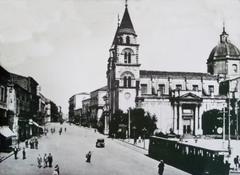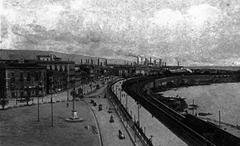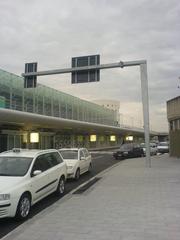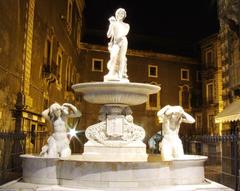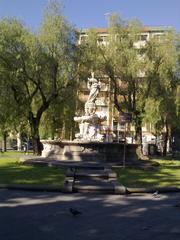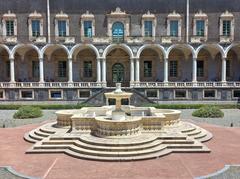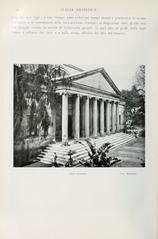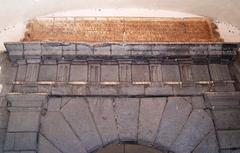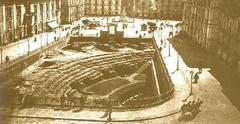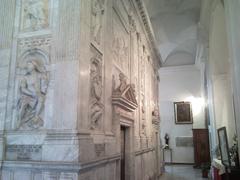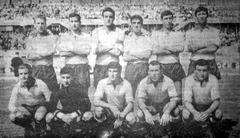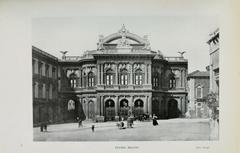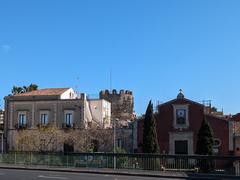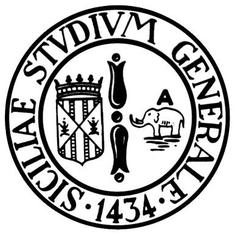Emilio Greco Museum Catania Visiting Hours Tickets and Historical Sites Guide
Date: 04/07/2025
Introduction to the Emilio Greco Museum including its history cultural significance and what visitors can expect
Nestled in the heart of Catania, Sicily, the Emilio Greco Museum offers an extraordinary cultural experience dedicated to one of Italy’s most celebrated 20th-century sculptors and graphic artists. Established in 1994 within the historic Palazzo Gravina Cruyllas, the museum honors Emilio Greco’s profound artistic legacy, showcasing over 150 works donated by the artist himself. This collection, rich in evocative sculptures, lithographs, and preparatory sketches, provides visitors with an intimate insight into Greco’s exploration of the human form, classical mythology, and Mediterranean sensuality. The museum’s unique setting—a late Baroque palace once home to the Princes of Palagonia—imbues the exhibition spaces with architectural grandeur, enhancing the dialogue between Catania’s aristocratic past and modern artistic expression. Beyond Greco’s masterpieces, the museum also features works by notable contemporaries such as Eugenio Russo and Hidetoshi Nagasawa, broadening the narrative of contemporary Italian sculpture.
Visitors can enjoy flexible opening hours, accessible facilities, and a variety of guided tours and cultural events designed to deepen appreciation for Greco’s work and Sicilian artistic heritage. Strategically situated near other cultural landmarks like the Museo Belliniano and the Benedictine Monastery of San Nicolò l’Arena, the Emilio Greco Museum forms a vital part of Catania’s vibrant cultural corridor. Whether you are an art enthusiast, a history buff, or a curious traveler, this museum invites you to immerse yourself in a rich tapestry of art, history, and Mediterranean identity. For detailed visitor information, including visiting hours, ticket prices, and accessibility, please refer to the official Comune di Catania website and curated insights at WhichMuseum.
Table of Contents
- Origins and Establishment of the Emilio Greco Museum
- Emilio Greco: Artistic Legacy and Influence
- Cultural and Historical Significance
- The Museum’s Collection and Exhibition Highlights
- Architectural and Artistic Context
- Visiting the Emilio Greco Museum: Hours, Tickets, and Accessibility
- Frequently Asked Questions (FAQ)
- Visual and Interactive Resources
- Explore More: Related Cultural Sites in Catania
- Stay Connected and Plan Your Visit
Origins and Establishment of the Emilio Greco Museum
The Emilio Greco Museum (Museo Emilio Greco) in Catania stands as a testament to the city’s commitment to celebrating its native artistic talent and preserving contemporary Italian art. Officially inaugurated in 1994, with the presence of Emilio Greco himself, the museum highlights the personal significance of the institution to both the artist and his hometown (Comune di Catania). Born in Catania in 1913, Greco rose to international prominence as a sculptor and graphic artist, and his generous donation of many works to his birthplace was pivotal in the museum’s foundation.
Housed within the historic Palazzo Gravina Cruyllas, a baroque palace that also accommodates the Bellini Civic Museum (Museo Belliniano), the museum benefits from a culturally rich setting. The palace, once home to the Princes of Palagonia, features ornate interiors including a family chapel and heraldic ceiling decorations, providing a fitting backdrop for Greco’s evocative works (WhichMuseum). This location situates Greco’s art within Catania’s aristocratic and artistic heritage, enhancing the visitor experience.
Emilio Greco: Artistic Legacy and Influence
Emilio Greco (1913–1995) is regarded as one of Italy’s foremost 20th-century sculptors. His oeuvre is marked by a profound sensuality and a distinctive Mediterranean classicism, with the female nude as a recurring motif. Celebrated for subtle eroticism that is nostalgic and idealized rather than provocative, Greco’s mastery of line and form shines through both his sculptures and graphic works, including lithographs and etchings, many of which are displayed at the museum (Comune di Catania).
The museum’s collection houses over 150 works donated by the artist himself, including sketches, drawings, and sculptures. These pieces offer insight into Greco’s creative process and his exploration of the human form, fragility, and idealized beauty. Additionally, works by Eugenio Russo (1910–2000), another prominent Catanian artist, broaden the museum’s representation of local contemporary art (WhichMuseum).
Cultural and Historical Significance
The Emilio Greco Museum holds a unique place in Catania’s cultural landscape as both a repository of Greco’s artistic legacy and a symbol of the city’s enduring relationship with its creative natives. Established in the 1990s, it marked an important moment in recognizing contemporary art within a city renowned for baroque architecture and ancient history.
Greco’s art, emphasizing the Mediterranean ideal and human sensuality, resonates deeply with Sicilian and southern Italian cultural identities. The collection’s dominant focus on female nudes reflects a classical heritage reinterpreted through a modern perspective. This blend of tradition and innovation is central to the museum’s mission and appeal (Comune di Catania).
Located in the Palazzo Gravina Cruyllas, the museum is near other cultural institutions like the Museo Belliniano, dedicated to composer Vincenzo Bellini. This proximity fosters a vibrant cultural corridor in Catania’s heart, encouraging visitors to explore the city’s rich artistic heritage (WhichMuseum).
The Museum’s Collection and Exhibition Highlights
At the core of the Emilio Greco Museum’s collection are over 150 works, primarily donated by Greco. The pieces focus on the female form, rendered with delicate sensuality and idealized beauty rather than strict anatomical precision.
Notable highlights include preparatory sketches for major public commissions such as the doors of Orvieto Cathedral and the Monument to Pinocchio in Collodi. These works reveal Greco’s creative process and his skill in translating two-dimensional studies into monumental sculptures. The museum also features a selection of Greco’s graphic works, showcasing his mastery of line and expressive drawing (Comune di Catania).
Complementing Greco’s works are pieces by Eugenio Russo, a contemporary Catanian artist, whose sculptures and drawings provide a broader context for modern art’s evolution in Sicily (WhichMuseum).
Architectural and Artistic Context
The Palazzo Gravina Cruyllas, with its baroque architecture and aristocratic heritage, is integral to the museum’s cultural significance. Its family chapel and heraldic decorations enrich the visitor experience and link Catania’s historical past with contemporary art achievements (WhichMuseum).
This historical setting encourages dialogue between art periods, allowing visitors to appreciate the evolution from baroque to modern artistic expressions, a defining feature enhancing the museum’s appeal.
Visiting the Emilio Greco Museum: Hours, Tickets, and Accessibility
- Location: Piazza San Francesco d’Assisi 3, Catania, inside Palazzo Gravina Cruyllas (WhichMuseum).
- Opening Hours: Monday to Saturday, 8:00–19:00; Sunday, 8:30–13:30 (Comune di Catania).
- Ticket Prices: General admission is €5; reduced tickets (EU citizens 18-25 years old) cost €3; free entry for visitors under 18, seniors over 65, and residents of Catania. Tickets can be purchased on-site; advanced booking is recommended for groups and guided tours.
- Guided Tours & Events: The museum offers guided tours on request and hosts occasional exhibitions and cultural events. Check the official website or Facebook page for updated schedules.
- Accessibility: The museum is wheelchair accessible, with ramps and elevators available for visitors with reduced mobility. Assistance is provided upon request.
- Facilities: The museum is centrally located and easily accessible, with nearby parking and public transport options. Visitor amenities include rest areas and informational brochures.
Nearby attractions include the Museo Vincenzo Bellini, the Benedictine Monastery of San Nicolò l’Arena, and the Historical Museum of the Landing in Sicily 1943, making the museum an excellent stop on a broader cultural itinerary (WhichMuseum).
Frequently Asked Questions (FAQ)
Q: What are the Emilio Greco Museum opening hours? A: The museum is open Monday to Saturday from 8:00 to 19:00, and Sunday from 8:30 to 13:30.
Q: How much are tickets to the Emilio Greco Museum? A: General admission is €5, with reduced tickets at €3 for EU citizens aged 18-25, and free entry for children under 18, seniors over 65, and Catania residents.
Q: Is the museum wheelchair accessible? A: Yes, the museum is wheelchair accessible with ramps and elevators, and assistance is available upon request.
Q: Are guided tours available at the Emilio Greco Museum? A: Guided tours can be booked on request, and the museum occasionally hosts special exhibitions and events.
Q: Where is the Emilio Greco Museum located? A: It is located at Piazza San Francesco d’Assisi 3, Catania, inside the historic Palazzo Gravina Cruyllas.
Visual and Interactive Resources
Visitors can explore an interactive map of the museum’s location and nearby historical sites on the official tourism website. Optimized images of key artworks and the museum’s baroque interiors are available online, complete with descriptive alt text such as “Emilio Greco Museum sculpture in Catania” and “Palazzo Gravina Cruyllas baroque ceiling.” Virtual tours may also be accessible through the museum’s digital platforms for remote visitors.
Explore More: Related Cultural Sites in Catania
For those interested in Catania’s rich artistic heritage, explore other nearby historical sites and museums such as the Museo Belliniano, the Benedictine Monastery of San Nicolò l’Arena, and the Historical Museum of the Landing in Sicily 1943.
Stay Connected and Plan Your Visit
For the latest information on exhibitions, events, and visitor updates, please visit the official Emilio Greco Museum website or follow their Facebook page.
Planning a visit to Catania? Download the Audiala app for curated cultural itineraries and insider tips on Catania’s historical sites and museums.
Enjoy your cultural journey through the Emilio Greco Museum and the artistic treasures of Catania!
Emilio Greco Museum Catania: Visiting Hours, Tickets & Art Highlights
Introduction
Nestled within the historic Palazzo Gravina Cruyllas, the Emilio Greco Museum in Catania is a must-visit destination for art lovers and cultural enthusiasts exploring Sicilian historical sites. Dedicated to the life and works of the renowned 20th-century Italian sculptor and graphic artist Emilio Greco, the museum offers an intimate glimpse into his artistic journey, showcasing a rich collection of sculptures, etchings, and lithographs. This guide covers essential visitor information including visiting hours, ticket details, and highlights of the collection to help you plan your visit.
Overview of the Permanent Collection
The Emilio Greco Museum houses approximately 150 autographed works spanning from 1955 to 1992, providing a comprehensive survey of Greco’s evolution over nearly four decades (WhichMuseum; Artsupp). Displayed within the baroque setting of the 17th-century Palazzo Gravina Cruyllas—with its original family coats of arms and private chapel—the collection creates a perfect atmosphere for appreciating Greco’s evocative art (Artsupp).
Key Works and Artistic Mediums
Etchings and Lithographs
Central to the collection are Greco’s graphic works, especially his etchings and lithographs that reveal his creative process and thematic depth. The acclaimed “25 Farewells” series, a poignant exploration of emotional detachment and human relationships, stands out as a highlight (Artsupp).
Classical mythology inspires many pieces such as:
- Nausicaa: Capturing Homer’s Phaeacian princess with grace.
- Arethusa: Emphasizing transformation through the mythological nymph.
- Euriclea: Exploring themes of fidelity and recognition.
- Medea: Delving into the tragic sorceress’s psychological depth.
- Sappho: Symbolizing creative passion.
- Metamorphosis: Reflecting recurring themes of change.
- Nymph and Faun: A sensual take on mythological archetypes.
- The Return of Ulysses: Portraying the hero’s homecoming trials.
Sculptures
Though primarily focused on graphic works, the museum also presents a curated selection of Greco’s bronze sculptures, known for their elongated forms and expressive gestures blending classical and modernist styles. While smaller than collections in Orvieto or Rome, these sculptures offer a tactile emotional experience (WhichMuseum).
Thematic Focus and Artistic Significance
Greco’s art embodies humanism and classical heritage, using the human figure to explore universal themes of identity, love, and transformation. His recurring motif of “tormented detachment,” especially visible in the “25 Farewells” series, masterfully conveys the emotional complexity of separation (Artsupp).
Additional Artworks and Guest Artists
The museum enriches its collection with works by contemporary artists like sculptor Eugenio Russo, enhancing visitors’ understanding of Italian sculpture. Notably, Hidetoshi Nagasawa’s “La Barca d’Oro” (“The Golden Boat”) offers a minimalist, poetic contrast to Greco’s figurative style, reflecting a fusion of Eastern and Western traditions (Artsupp; WhichMuseum).
Visiting Information
- Visiting Hours: The museum is open Tuesday to Sunday from 9:00 AM to 6:00 PM. It is closed on Mondays and public holidays. Please check the official website or local listings for seasonal changes.
- Tickets: Entrance fees are modest, with reduced prices available for students and seniors. Tickets can be purchased onsite; advance booking is recommended during peak tourist seasons.
- Accessibility: The museum strives to accommodate visitors with mobility challenges, featuring ramps and accessible pathways.
- Guided Tours & Events: Occasionally, the museum offers guided tours and special events focusing on Greco’s life and themes within his work. Check the museum’s announcements for schedules.
- Photography: Visitors are encouraged to photograph the artworks where permitted; specific photographic spots within the Palazzo Gravina Cruyllas provide excellent framing opportunities.
Practical Tips and Nearby Attractions
Located in the heart of Catania, the museum is easily accessible by public transport or on foot from major city landmarks. Nearby, visitors can explore other Catania historical sites such as the Belliniano Civic Museum dedicated to Vincenzo Bellini, also housed in the same palace, enriching your cultural itinerary.
Visuals and Media
The museum offers an online virtual tour and a gallery of curated images with descriptive alt texts optimized for “Emilio Greco Museum visiting hours” and “Emilio Greco Museum tickets” to enhance the digital visitor experience.
Frequently Asked Questions (FAQ)
Q: What are the Emilio Greco Museum visiting hours? A: Tuesday to Sunday, 9:00 AM to 6:00 PM. Closed Mondays.
Q: Are tickets required to enter the museum? A: Yes, tickets are required and can be purchased onsite or booked in advance.
Q: Is the museum accessible for people with disabilities? A: Yes, the museum provides accessibility features including ramps.
Q: Are guided tours available? A: Guided tours are offered periodically; check the museum’s website for current schedules.
Conclusion and Call to Action
The Emilio Greco Museum in Catania offers a deep, engaging experience into the work of a key figure in Italian art, set against the beautiful backdrop of a historic Sicilian palace. Whether you are an art aficionado or a curious traveler visiting Catania historical sites, the museum promises an enriching journey through emotion, myth, and humanism.
Plan your visit today and don’t forget to download the Audiala app for guided tours and exclusive content. Explore more cultural posts on our site and follow us on social media for the latest updates on exhibitions and events.
Visiting the Emilio Greco Museum in Catania: Hours, Tickets, and Cultural Highlights
Introduction: Why Visit the Emilio Greco Museum?
Located in the vibrant city of Catania, Sicily, the Emilio Greco Museum is a must-visit destination for art lovers and history enthusiasts alike. Showcasing the works of the renowned Italian sculptor Emilio Greco, alongside contemporary artists, this museum offers a unique cultural experience set within two iconic historic buildings: Palazzo Gravina Cruyllas and Palazzo della Cultura. Whether you are planning your visit or simply exploring Catania’s rich artistic scene, this guide will provide you with essential information on visiting hours, tickets, exhibitions, and more.
Explore Palazzo Gravina Cruyllas: A Historical Gem in Catania
The Emilio Greco Museum is primarily housed in Palazzo Gravina Cruyllas, a striking example of late Baroque architecture in the heart of Catania. Situated at the crossroads of Via Vittorio Emanuele II and Piazza San Francesco, this historic palace was rebuilt starting in 1695 after the devastating 1693 Sicily earthquake. Its grand central portal, ornate façade, and noble heritage make it an impressive backdrop for Greco’s classical and mythological sculptures.
Visitors to the museum can enjoy rooms that retain much of their original residential charm, with period architectural details and views overlooking central Catania’s bustling streets. Palazzo Gravina Cruyllas also holds cultural significance as the birthplace of famed opera composer Vincenzo Bellini, whose legacy is celebrated nearby in the Museo Civico Belliniano.
Discover Palazzo della Cultura: The Museum’s Modern Extension
Complementing the historic palace, the Emilio Greco Museum also occupies space in the Palazzo della Cultura, formerly the San Placido Convent. This modern cultural venue is located just steps away at Via Vittorio Emanuele II, 121. The Palazzo della Cultura offers spacious galleries, a large art library, and facilities for temporary exhibitions and educational programs, making it an accessible and contemporary space for art appreciation.
Interestingly, this building connects to Greco’s personal history, as it once housed his elementary school. The blend of history and modernity here perfectly reflects Catania’s dynamic cultural landscape.
Emilio Greco Museum Visiting Hours and Ticket Information
- Location: Via Vittorio Emanuele II, 119 (Palazzo Gravina Cruyllas) and Via Vittorio Emanuele II, 121 (Palazzo della Cultura), Catania.
- Main Entrances: Piazza San Francesco d’Assisi, 3 and Via Vittorio Emanuele II, 121.
- Opening Hours: Typically open Monday to Saturday from 9:00 AM to 1:00 PM, Sundays and holidays from 10:00 AM to 1:00 PM. Hours can vary, so check the official website or contact the museum before your visit.
- Admission Fees: Entry is often free or requires a small fee (approximately €2.00), making it affordable for most visitors.
- Accessibility: Both sites strive to accommodate visitors with mobility challenges, but facilities may differ between the two buildings. It is recommended to inquire in advance if you have specific needs.
- Guided Tours: Guided tours are occasionally available; visitors should check ahead to book or confirm availability.
What to See: Highlights of the Museum Collection
The Emilio Greco Museum features around 150 autographed works by Greco, created between 1955 and 1992. His sculptures often explore classical themes, mythological figures, and human emotion. The museum also showcases works by contemporary artists like Eugenio Russo and Hidetoshi Nagasawa, providing a broader view of Italy’s modern artistic scene.
The carefully preserved historic interiors of Palazzo Gravina Cruyllas add depth to the viewing experience, while the Palazzo della Cultura’s modern galleries offer flexible spaces for special exhibitions and events.
Practical Visitor Tips for Your Emilio Greco Museum Experience
- Plan Your Visit: Combine your museum trip with nearby attractions such as Catania Cathedral, Castello Ursino, and the Monastery of San Nicolò l’Arena for a full cultural day.
- Photography: Check museum policy on photography; respectful use of cameras is usually permitted without flash.
- Local Amenities: Cafes and shops are available nearby for refreshments and souvenirs.
- Special Events: The Palazzo della Cultura regularly hosts exhibitions, concerts, and educational programs; check their schedule for any events during your visit.
Frequently Asked Questions (FAQ)
Q: Are tickets required for the Emilio Greco Museum? A: Tickets are usually free or available for a small fee. It is best to check current information on the official museum site before your visit.
Q: What are the museum’s opening hours? A: The museum is generally open Monday to Saturday from 9:00 AM to 1:00 PM, and Sundays/holidays from 10:00 AM to 1:00 PM. Hours may vary by season.
Q: Is the museum accessible for visitors with disabilities? A: Both locations strive to be accessible, but facilities may vary. Contact the museum directly to confirm accommodations.
Q: Can I take guided tours? A: Guided tours may be available upon request or during special events. Advance booking is recommended.
Q: Are there other cultural sites near the museum? A: Yes, the museum is centrally located near Catania Cathedral, Castello Ursino, and the Museo Civico Belliniano, making it easy to explore multiple historical sites in one visit.
Conclusion: Experience the Artistic Heart of Catania at the Emilio Greco Museum
The Emilio Greco Museum, with its unique dual setting in the historic Palazzo Gravina Cruyllas and the modern Palazzo della Cultura, offers visitors a rich journey through art, history, and architecture. From Baroque grandeur to contemporary cultural spaces, the museum is a highlight of Catania’s vibrant cultural scene. Plan your visit today to explore Greco’s evocative sculptures and immerse yourself in the city’s artistic heritage.
Additional Resources and Links
- Visit the official Emilio Greco Museum website for updates.
- Explore the Museo Civico Belliniano near Palazzo Gravina Cruyllas.
Call to Action
Ready to explore the Emilio Greco Museum and other cultural treasures of Catania? Download the Audiala app for curated travel guides and insider tips to make the most of your Sicilian adventure. Follow us on social media for the latest updates, event announcements, and exclusive content. Start your journey into the heart of Catania today!
Location and Accessibility of Emilio Greco Museum
The Emilio Greco Museum is centrally located in Catania at Via Vittorio Emanuele II, 119, within the historic Palazzo della Cultura. This prime location places the museum in the heart of the city’s vibrant cultural district, making it easily accessible on foot from many of Catania’s main attractions, including Piazza del Duomo and the Bellini Museum. For visitors arriving by public transport, several city bus lines stop nearby, and the museum is a short walk from the main Via Etnea thoroughfare. The area is pedestrian-friendly, and taxis are readily available throughout the city center (Comune di Catania).
Emilio Greco Museum Visiting Hours and Admission Tickets
The Emilio Greco Museum maintains visitor-friendly hours throughout the week:
- Monday to Saturday: 09:00 – 19:00
- Sunday and Public Holidays: 09:00 – 13:00
These extended visiting hours allow for flexible planning, whether you prefer a morning visit or an afternoon immersed in art. The museum is closed only on select holidays, so it is advisable to check the official Comune di Catania website for any updates or special closures.
Admission Tickets and Prices:
- Standard Ticket: €5.00 (includes joint entry to the Bellini Museum)
- Reduced Ticket: €2.00 (available for youths aged 10–18, university students under 26, Catania residents, groups of more than 10, and families of at least four)
- School Groups: €1.00 per student
- Free Admission: Children under 10 and holders of the “Catania Pass”
(CityMap Sicilia)
Tickets can be purchased at the entrance. For guided tours, advance reservation is required, which can be arranged by contacting the museum directly.
Museum Facilities and Accessibility for Visitors
Housed within the Palazzo della Cultura, the Emilio Greco Museum is adapted to accommodate visitors with varying needs. The museum is wheelchair accessible, with ramps and elevators available for those with mobility challenges. Restrooms are located on the premises, and there is a cloakroom for storing bags and coats during your visit.
Photography is generally permitted for personal use, but flash and tripods are not allowed to protect the delicate graphic works. Visitors interested in sketching or note-taking are welcome to bring small notebooks and pencils.
Guided Tours and Educational Programs at Emilio Greco Museum
Guided tours are available by reservation and highly recommended for visitors seeking deeper insight into Emilio Greco’s artistic legacy. These tours are led by knowledgeable guides who provide context on Greco’s life, his artistic techniques, and the significance of the works on display. Tours can be tailored for school groups, families, or art enthusiasts and are available in multiple languages upon request (CityMap Sicilia).
The museum also hosts educational workshops and temporary exhibitions featuring both established and emerging artists, making each visit potentially unique. Check the museum’s event calendar for special programming, particularly during the Catania Summer Fest and other citywide cultural events.
Must-See Highlights and Collection Focus of Emilio Greco Museum
The museum’s permanent collection consists of approximately 150 graphic works by Emilio Greco, created between 1955 and 1992. These works primarily focus on the female nude, a recurring theme in Greco’s oeuvre, characterized by delicate lines and an evocative sense of fragility. The collection offers a comprehensive overview of Greco’s evolution as an artist, from his early sketches to his mature style.
Key highlights include:
- Self-Portraits: Greco’s introspective self-portraits provide a window into the artist’s psyche and creative process.
- Female Nudes: The museum’s core collection, celebrated for elegance, sensuality, and technical mastery.
- Preparatory Drawings: Pieces that reveal Greco’s methodical approach to sculpture and printmaking, offering insight into his artistic development.
Temporary exhibitions are regularly staged, showcasing both Greco’s contemporaries and new voices in Italian and international art.
Visitor Experience and Atmosphere at the Emilio Greco Museum
Known for its tranquil and contemplative atmosphere, the Emilio Greco Museum’s exhibition spaces are thoughtfully arranged to allow visitors to engage closely with the artworks. The lighting enhances the viewing experience without causing damage to the delicate paper works.
The museum’s location within the Palazzo della Cultura also allows visitors to appreciate the building’s architectural features, including grand staircases and period details. The staff are friendly and knowledgeable, often willing to answer questions or provide recommendations for further exploration in Catania’s cultural scene.
Nearby Attractions and Amenities to Explore
The museum’s central location makes it an ideal starting point for exploring other cultural landmarks:
- Bellini Museum: Located nearby in the eighteenth-century Cruyllas Gravina Palace, dedicated to composer Vincenzo Bellini and offering insights into his life and legacy (CityMap Sicilia).
- Saint Francesco and Immaculate’s Church: An eighteenth-century church known for its impressive holy artworks and role in the annual St. Agatha celebrations.
- Herborarium Museum: A multidisciplinary space promoting art, culture, and science, also the seat of the Presidium of the Book of Catania.
For refreshments, several local eateries are within walking distance:
- Deliziosa: Offers Sicilian pasta dishes, seasoned breads, and traditional second courses.
- Canusciuti Sicilian Café: Renowned for street food, including 15 types of arancini, cannoli, and other local specialties.
For shopping, Iride Ceramiche is an artisan workshop specializing in hand-decorated ceramics and unique gift items (CityMap Sicilia).
Expert Tips for a Memorable Visit to Emilio Greco Museum
- Combine Visits: Use the joint ticket with the Bellini Museum to enrich your cultural experience.
- Arrive Early: Visit in the morning, especially on weekdays, for a quieter atmosphere and more time with the artworks.
- Check for Events: Look out for citywide festivals such as the Catania Summer Fest, which often feature special exhibitions and events.
- Guided Tours: Book in advance for a more in-depth understanding of Greco’s work and museum history.
- Photography: Follow the museum’s no-flash, no-tripod photography policy to help preserve the collection.
- Accessibility: Contact the museum ahead if you have specific accessibility needs to ensure accommodations.
- Local Cuisine: Enjoy a meal at nearby Sicilian eateries to complete your cultural immersion.
- Souvenirs: Visit Iride Ceramiche for unique, locally crafted gifts and mementos.
Frequently Asked Questions (FAQ) about Emilio Greco Museum
Q: Where can I buy tickets for the Emilio Greco Museum?
A: Tickets can be purchased at the museum entrance. For guided tours, advance reservation is recommended.
Q: What are the Emilio Greco Museum’s visiting hours?
A: The museum is open Monday to Saturday from 09:00 to 19:00 and on Sundays and public holidays from 09:00 to 13:00.
Q: Is the museum wheelchair accessible?
A: Yes, the museum is wheelchair accessible with ramps and elevators.
Q: Are guided tours available?
A: Yes, guided tours are available by reservation and can be tailored to different groups and languages.
Q: Can I take photographs inside the museum?
A: Photography is allowed for personal use, but flash and tripods are prohibited.
Q: What can I expect to see in the museum’s collection?
A: The museum features about 150 graphic works by Emilio Greco, focusing on female nudes, self-portraits, and preparatory drawings.
Q: Are there any nearby attractions worth visiting?
A: Yes, the Bellini Museum, Saint Francesco and Immaculate’s Church, and the Herborarium Museum are all nearby.
Practical Contact Information for Emilio Greco Museum
- Address: Via Vittorio Emanuele II, 119, 95131 Catania, Italy
- Phone: Refer to the Comune di Catania official page for up-to-date contact details.
- Website: Comune di Catania – Museo Emilio Greco
- Tourist Info Point: Info Point Sicily Excursions nearby offers certified tourism services and local recommendations (CityMap Sicilia).
Plan your visit today and immerse yourself in the artistic world of Emilio Greco! Download the Audiala app for up-to-date information on museum hours and special events. Explore related posts on Catania historical sites and follow us on social media for the latest news and visitor tips. Your memorable cultural journey in Catania awaits!
Summary of key points visitor tips and call to action to stay updated and explore more
The Emilio Greco Museum in Catania stands as a compelling tribute to the artistic genius of Emilio Greco and the rich cultural fabric of Sicily. Its thoughtfully curated collection offers an unparalleled window into Greco’s creative evolution, emphasizing themes of classical heritage, human sensuality, and emotional depth. Housed in the architecturally magnificent Palazzo Gravina Cruyllas and complemented by the modern spaces of the Palazzo della Cultura, the museum seamlessly bridges historical grandeur with contemporary artistic dialogue. Visitors benefit from comprehensive amenities, accessible facilities, and enriching guided tours that bring the stories behind the sculptures and graphic works to life. Coupled with its prime location amid Catania’s notable historical sites, the Emilio Greco Museum is a must-see destination for anyone seeking to explore Italian art within a vibrant cultural context.
For those planning a visit, it is recommended to check current visiting hours and ticket information through the official channels and consider guided tours to fully appreciate the nuances of Greco’s work. Additionally, exploring nearby attractions such as the Museo Belliniano and the Benedictine Monastery can enhance your cultural itinerary. Stay informed about special exhibitions and events by visiting the museum’s official website and social media pages. Embark on a memorable journey through art and history in Catania, and enrich your experience with the Audiala app’s curated cultural itineraries. Your artistic exploration awaits at the Emilio Greco Museum. For more information, visit the Comune di Catania official page and detailed visitor insights at WhichMuseum.
References and links to official museum website related articles and credible sources
- Emilio Greco Museum Catania: Visiting Hours, Tickets, and Cultural Highlights, 2025, Comune di Catania https://turismo.comune.catania.it/en/discover-catania/museums/historical-and-archaological/museo-emilio-greco/
- Emilio Greco Museum Catania: Visiting Hours, Tickets & Art Highlights, 2025, Artsupp & WhichMuseum https://whichmuseum.com/museum/museo-emilio-greco-catania-38689
- Visiting the Emilio Greco Museum in Catania: Hours, Tickets, and Cultural Highlights, 2025, WhichMuseum https://whichmuseum.com/museum/museo-emilio-greco-catania-38689
- Emilio Greco Museum Visiting Hours, Tickets, and Guide to Catania’s Cultural Gem, 2025, Comune di Catania & CityMap Sicilia https://www.comune.catania.it/la-citta/culture/monumenti-e-siti-archeologici/musei/museo-emilio-greco/
